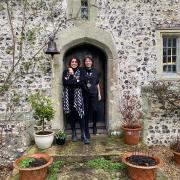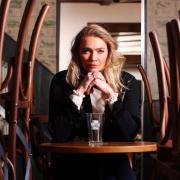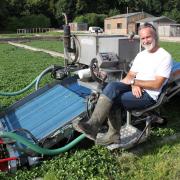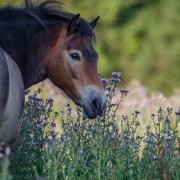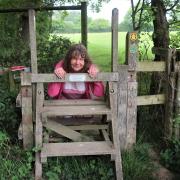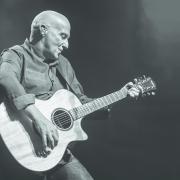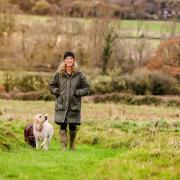He’s the feisty frontman of one of the greatest rock bands. And through it all, his rock-solid family and Sussex home have been his sanctuary
He’s famous for that scream on Won’t Get Fooled Again, the furious rebellion of My Generation and a whole lot of bare-chested, microphone-swinging. But today Roger Daltrey – singer, actor, former trout farmer and philanthropist – is sitting quietly in the corner of a cosy, softly-lit room in a genteel Georgian hotel in central London.
He stands up to shake my hand and greets me with a warm, slightly crooked smile (he broke his jaw as a child). He’s 74 and still in great shape, looking sharp in a crisp black shirt with slim-fitting black jeans, a full head of curls and his blue-tinted glasses.
So how did he balance his rock career and home life? “Some of my friends in the business found it hard to readjust to a normal family existence after the madness on the road. Me? No problem. I lived in the moment. If the moment involved standing in front of thousands of people with a drummer passed out on his drums, I’d deal with it. If it involved hosting 100 aunts and uncles, nieces, third cousins and nephews twice removed, no problem,” he says. “I used to import the whole family by coach on Christmas Day, about 60 of them, to have a beano in Sussex. I remember Christmas 1976 when Dad looked me in the eye and said, ‘Isn’t it grand?’ He was happy and that meant the world to me.”
He seems very down to earth, happy in his own skin. He’s the only member of The Who who never got into hard drugs and he’s been married for a mighty 51 years. “Heather and I were in the first flush of marriage when the kids started coming along: Rosie and then Willow three years later. When we had our son Jamie in 1981 I got to have a go at the hands-on dad routine. It didn’t matter how crazy things got on the road, I knew I was always coming back to stability,” he says.
Home for the last 48 years has been Holmshurst Manor near Burwash. Dating back to 1610, it’s a Jacobean Grade II listed manor house with 20 rooms, 12 stone fireplaces and stained-glass windows by the pre-Raphaelite artist Edward Burne-Jones. It’s surrounded by beautiful farmland and not far from Rudyard Kipling’s house, Bateman’s. The Cure’s Robert Smith is a neighbour.
Roger remembers the spring day in 1970 when he and Heather first set eyes on Holmshurst. “The hallway was black as pitch, there was damp, the kitchen was terrible. Then we walked up to the front room and I saw the view. The house is on a hill looking across the valleys and villages of the High Weald of East Sussex. You can see for miles and miles and miles and miles. I stood open-mouthed and knew I had to live there. We moved into the place that would be our home for the rest of our lives on 26 June 1971. Holmshurst is a very special house and it grounded me. It was built for a Quaker. There’s nothing fancy about it. It’s a simple, functional place which suits me.” Under his care (“You never own a listed house, you are a caretaker”) the estate has grown from 35 to 420 acres and is now home to 230 cows, and four lakes which Roger and a friend created.
“It took me ten years to decorate Holmshurst. At some point the owners had decided to stain all the beams black and it took seven summers to get them back to their original honey colour. When I wasn’t scrubbing, I was digging. The lake was not much more than a muddy puddle. So I enlisted the help of Herbert, the son of the publican who ran our local, The Kicking Donkey. We spent happy weeks digging out the silt and raising the dam until I had a proper lake.
“I ended up with four interconnected lakes and could invite all my old workmates from the sheet metal factory to come fishing. They would sit there by the water and tell me it was criminal, Rog, to keep all this to yourself. And of course they were right. So I opened Lakedown Trout Fishery to the public and met lots of people who were more interested in fish than rock star Roger,” he smiles.
I ask if being in nature is a sanctuary for him. “Yes, it always was,” he replies. He spent his early childhood living with his parents, younger sisters, uncle aunt and cousins in rented rooms in Shepherds Bush, west London. “The happiest times of my childhood were when I found nature. I skipped away to the river or found some overgrown bombsite to play in. The wrecked basements had filled with water and become a home to frogs and toads. They were like tiny nature reserves. From the age of about three, I was always running off to play on the bombsites. I called it ‘running away to the country’!”
His affection for Sussex goes back to his childhood – when the whole Daltrey brigade used to rent a house in Brighton for their holidays. “We stayed at 11 Chapel Street, above the promenade,” he reminisces. “When I was 13 or 14, I used to take my guitar and busk by the pier. I took my record player and played a few Buddy Holly and Lonnie Donegan records.” And of course Brighton has played a part in his stellar career – particularly as the setting for the rock opera album and film Quadrophenia.
Sixty years on, he has an enduring fondness for the county, explaining: “I love walking on the Sussex Weald and I like the ruggedness, the reality about East Sussex. It’s not too much up its own arse. There’s a good London saying for you! I love Hastings. It’s rough round the edges, a rough diamond. Some of the architecture in St Leonards and Hastings is to die for. How it’s not protected I don’t know.”
He’s keen to talk about the rural problems he sees around him. “It’s tough land to farm and the council frustrates the hell out of me because it’s an AONB (Area of Outstanding Natural Beauty). People need to remember that the patchwork quilt of the Weald only exists because of farming and farm animals.
“My pocket of the High Weald – from Burwash to Wadhurst and Mayfield – has many issues the council seriously needs to address. “To their credit we had a newly [asphalted] lane that was wonderful for about three years. But then they decided to give it a coating of tar and chips. Because they hadn’t swept the road of mud from tractor tires properly they tarred and chipped over the mud. Come winter, those mud pieces freeze and blow off the top tar and chip. So they have, in effect, seeded the whole road with potholes. I watched them do it and thought ‘this is insanity’.”
He’s written to the council and even had them out to see uncut hedges growing dangerously far into the road. “But it gets forgotten again after a year. Lorries have to drive down part the road with one wheel in the other lane. With the hedges cut back these roads are barely wide enough for trucks to pass each other. There are two schools and a railway station along the road. It has all the ingredients for a horrendous accident. The council need to write to the landowners and tell them to cut their hedges.”
When Sussex Life approached East Sussex County Council a spokesman said: “Overhanging hedgerows does cause a danger to motorists and pedestrians and we have worked with partners including the National Farmers Union to highlight this issue. While our stewards can advise, it is the duty of landowners, including homeowners, farmers and business owners, to cut back trees and hedges which overhang the public highway. Last year we resurfaced 71 miles of road in East Sussex and our contractor always strives to do the best possible job.” The council added that anyone aware of any specific issues should contact them.
Roger is equally passionate about giving something back to teenagers – the people who gave The Who a career. He’s raised more than £25m for the Teenage Cancer Trust and also launched Teen Cancer America. He’s patron of the British and Irish Modern Music Institute (BIMM) based in Brighton and Wealden Works, a scheme to encourage 16-24 year olds in rural areas into further education, volunteering, work experience and ultimately paid employment. “Youngsters without ambition or drive or with problematic families find it so hard,” he says. He seems to have a special empathy with youngsters. “I remember that time of my life being the most difficult. We need to start to understand that age group a lot better.”
I ask if he’s having a big family Christmas at home this year. “Yep. We can get 12 or 14 round the dinner table. We’ll be with the grandkids.” And are there any family Christmas traditions? “My youngest grandchild, by my daughter Willow, always stays the night here on Christmas Eve. He’s started the mumble period!”
And how does he stay looking so trim and well?
“I try and keep the weight down and I like to work. I stay busy. It keeps you alive.”
More…
• Sussex celebrities share what they love most about the county - Some of Sussex’s best known personalities have revealed in the magazine what they most love about the county. Here, we compile their stories, favourite restaurants, pubs, shops, views and places to visit




